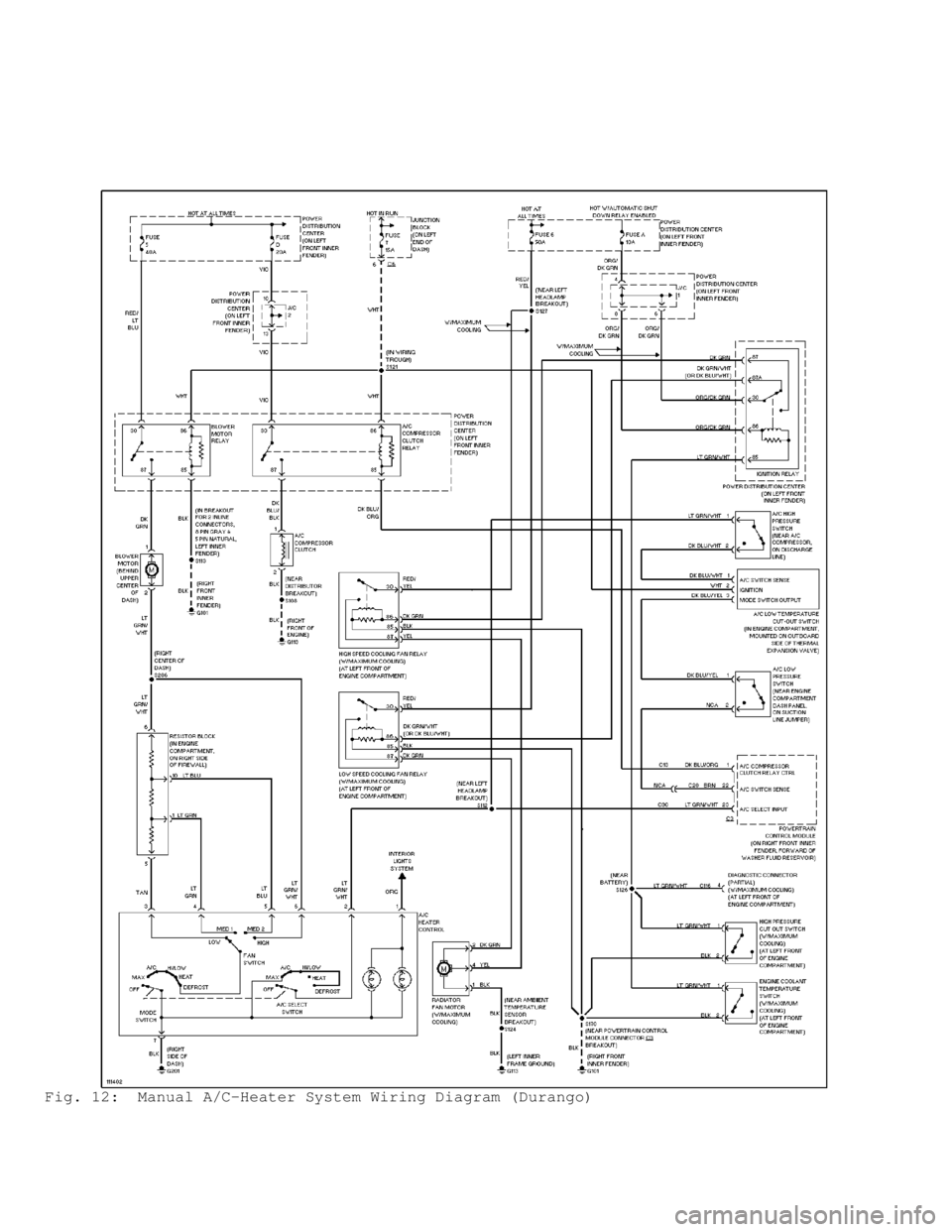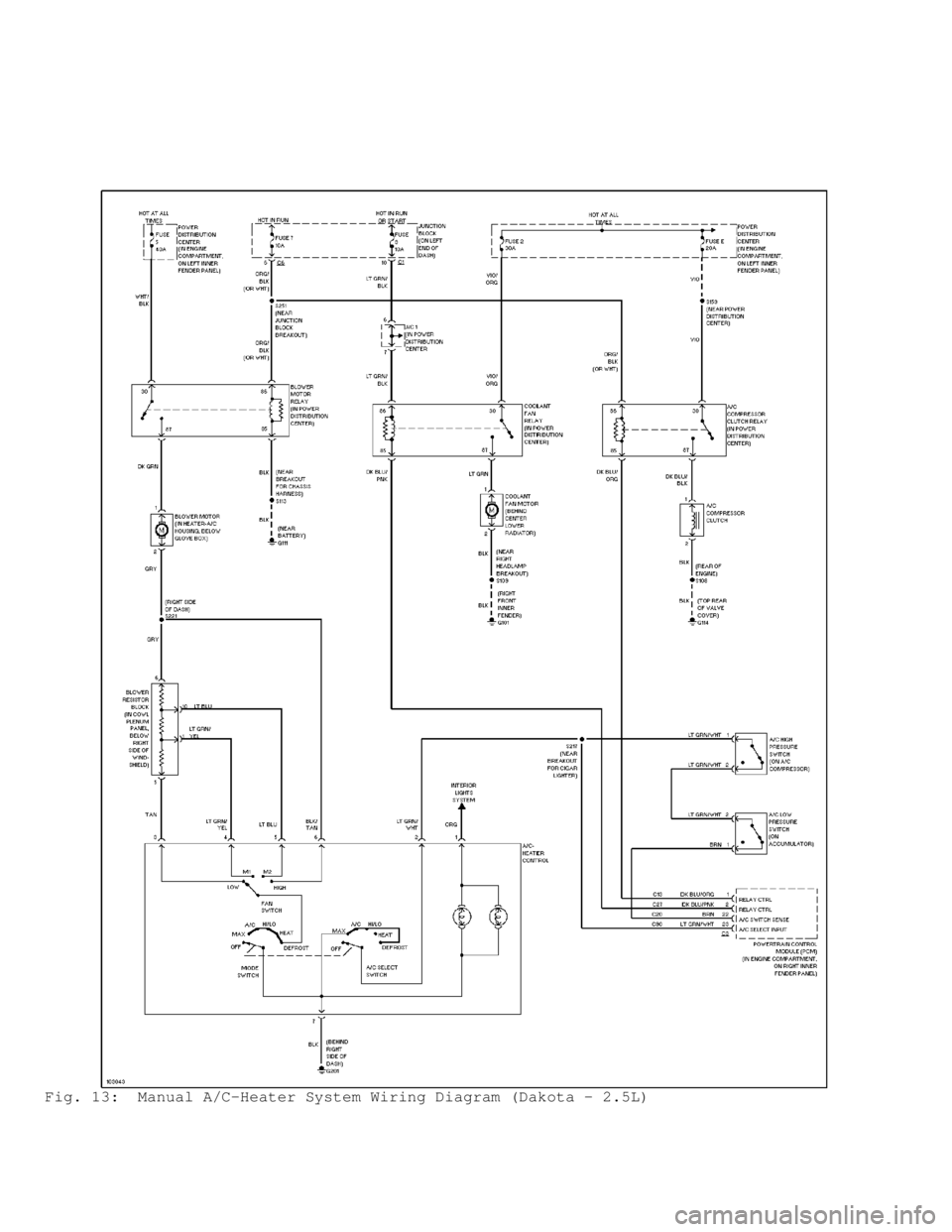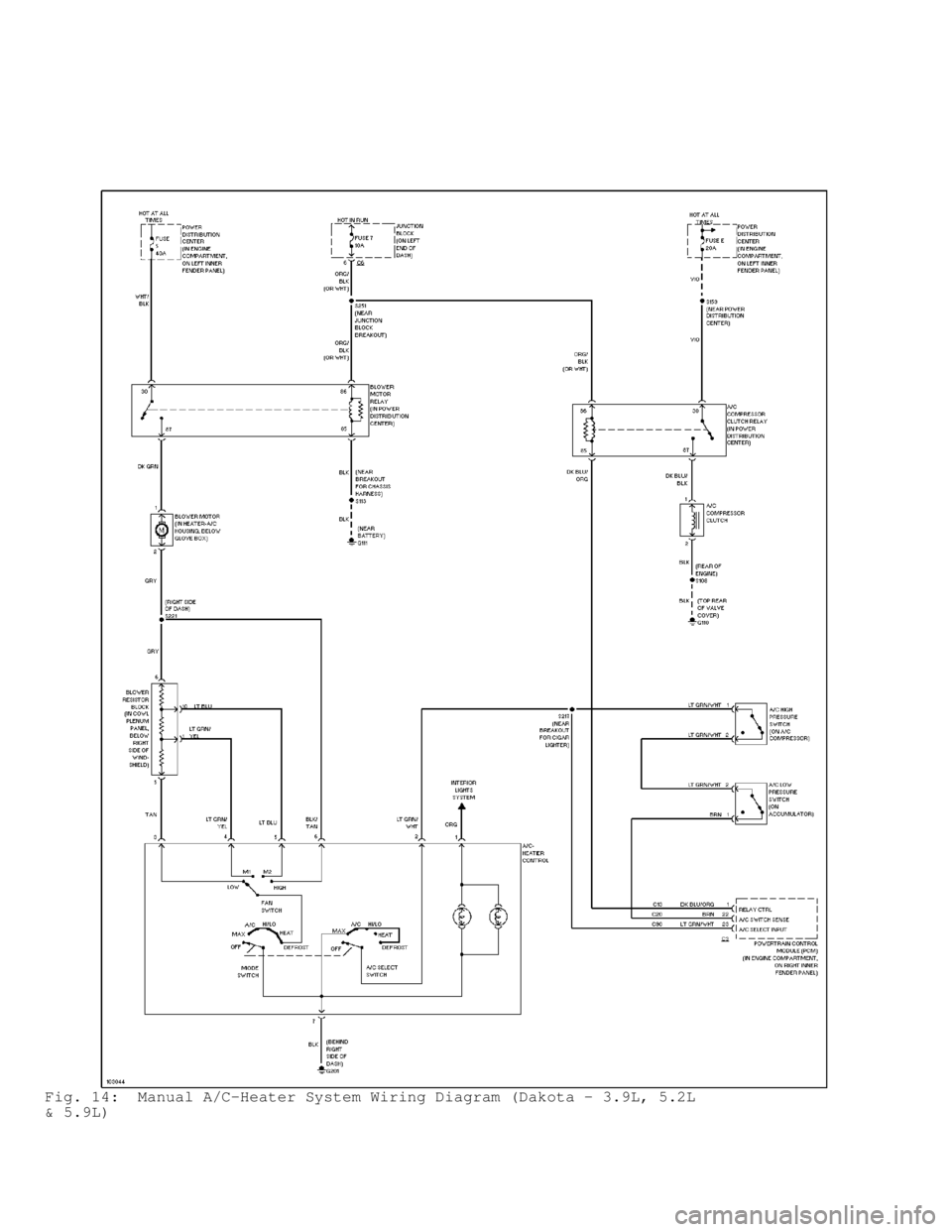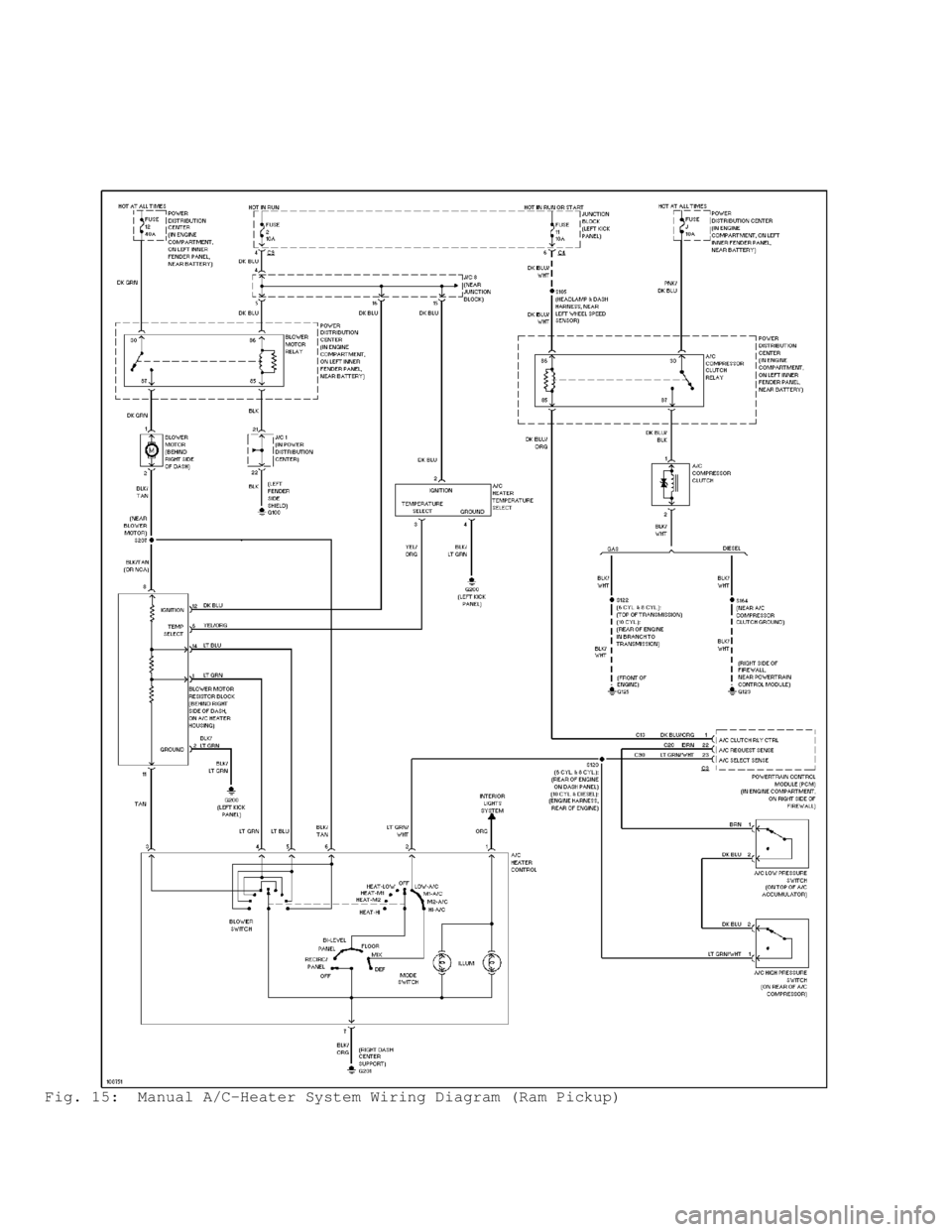1999 DODGE RAM wiring
[x] Cancel search: wiringPage 114 of 1691

Fig. 12: Manual A/C-Heater System Wiring Diagram (Durango)
Page 115 of 1691

Fig. 13: Manual A/C-Heater System Wiring Diagram (Dakota - 2.5L)
Page 116 of 1691

Fig. 14: Manual A/C-Heater System Wiring Diagram (Dakota - 3.9L, 5.2L
& 5.9L)
Page 117 of 1691

Fig. 15: Manual A/C-Heater System Wiring Diagram (Ram Pickup)
Page 167 of 1691

2) Disconnect vacuum line at PCV valve located in valve
cover. Install .185" fixed orifice Air Metering Fitting (6714) into
disconnected vacuum line in place of PCV valve.
3) Disconnect purge vacuum hose from passenger's side front
corner of throttle body, next to MAP sensor. Place cap on vacuum hose
fitting on throttle body.
4) Connect scan tool to Data Link Connector (DLC) located
below driver's side of instrument panel, near steering column. See
Fig. 1, 2 or 3.
5) Start engine and warm engine to normal operating
temperature. Using scan tool manufacturer's instructions, select
SYSTEM TEST and then access the MINIMUM AIRFLOW display on scan tool.
When accessed, scan tool will count down to stabilize idle RPM and
display minimum airflow idle RPM. Minimum airflow idle RPM should be
500-900 RPM.
6) Shut engine off. If minimum airflow idle RPM is correct,
throttle body is okay. Go to next step. If minimum airflow idle RPM is
not within specification, using approved cleaner, clean throttle body
and recheck minimum airflow idle RPM. If correct minimum airflow idle
RPM cannot be obtained, replace throttle body. Go to next step.
7) Remove air metering fitting. Reinstall vacuum hoses as
necessary. Reinstall air duct on throttle body. Remove scan tool.
Ram Pickup 8.0L
Throttle body minimum airflow cannot be checked on this
application.
THROTTLE POSITION SENSOR
NOTE: Throttle Position (TP) sensor is nonadjustable. Use following\
procedure to check TP sensor calibration. For complete
testing of TP sensor and wiring circuit, see SELF-DIAGNOSTICS
- JEEP, TRUCKS & RWD VANS article.
Dakota, Ram Pickup, Ram Van & Ram Wagon
1) Remove components for access to electrical connector at TP
sensor mounted on throttle body. With electrical connector installed
on TP sensor, turn ignition on with engine off. DO NOT start engine.
2) Using digital volt-ohmmeter, measure voltage at center
terminal on electrical connector for TP sensor with throttle valve
closed (idle position). Voltage should be greater than .35 volt, but
less than .90 volt.
3) Slowly open throttle to full throttle and note voltage
reading. Voltage should smoothly increase to less than 4.50 volts.
Replace TP sensor if voltage is not within specification.
Page 174 of 1691

protective cover is fitted to front of air bag module bearing the SRS
air bag logo. Air bag module contains air bag cushion, inflator and
supporting components. Air bag module is a sealed unit and is not
serviceable. The module inflator assembly produces nitrogen gas to
fill air bag cushion when a small amount of current from ACM is
applied to the ignitor assembly. Gas pressure builds and discharges
from inflator through a diffuser and screen assembly, forcing steering
wheel cover to burst along its seams until air bag is fully inflated.
Once air bag cushion is fully inflated, gas escapes from bag through
vents, away from driver.
Passenger-Side
Air bag module is mounted to instrument panel mounting
bracket. Module is covered by a protective door bearing the SRS air
bag logo. When supplied an electrical signal, inflator will discharge
argon gas directly into air bag. When air bag inflates, protective
door will pivot aside allowing air bag to deploy.
AIR BAG CONTROL MODULE (ACM)
ACM is located under instrument panel, on transmission
tunnel. Impact sensor, energy reserve capacitor and On-Board
Diagnostics (OBD) are an integral part of ACM. ACM monitors critical
input and output circuits within air bag system, ensuring they are
operating correctly. Some circuits are tested continuously; others are
checked only under certain conditions. ACM provides information about
air bag system through AIR BAG warning light and Data Link Connector
(DLC). When diagnostic trouble code (fault message) is stored, AIR B\
AG
warning light will be activated for 12 seconds or more.
DATA LINK CONNECTOR (DLC)
DLC is located under left side of instrument panel, left of
steering column. DLC is used to access SRS on-board diagnostics.
CLOCKSPRING
Clockspring connects air bag module to steering column
wiring, completing air bag system circuit. See Fig. 1. Inside
clockspring is a flat, ribbon-like tape of conductive material, which
winds and unwinds with steering wheel movement. Clockspring is the
most fragile part of air bag system. Clockspring must be centered
properly to allow 1 1/2 steering wheel turns in either direction. If
clockspring is not centered properly, it can break from stretching or
fatigue.
Fig. 1: Identifying Clockspring Assembly
Courtesy of DaimlerChrysler Corp.
Page 177 of 1691

WARNING: Vehicle interior will contain sodium hydroxide powder, a
by-product of air bag deployment. Since this powder can
irritate skin, eyes, nose, or throat, be sure to wear
safety glasses, rubber gloves and long-sleeved shirt
during clean-up.
1) Begin clean-up by putting tape over air bag exhaust vent,
so no additional powder will escape into vehicle interior. Remove air
bag modules. Use a vacuum cleaner to remove any residual powder from
vehicle interior. To avoid kneeling or sitting on a non-cleaned area,
clean from outside vehicle and work your way inside.
2) Remove any residual powder from A/C-heater outlets. Turn
blower motor to low for a few minutes and exit vehicle. Turn blower
off. Vacuum any additional powder expelled from plenum. Vacuum
interior a second time to recover all powder.
DEPLOYED AIR BAG
Dispose of deployed air bag module as any other part. No
special disposal procedure is required.
UNDEPLOYED AIR BAG
NOTE: Information on passenger-side air bag deployment is not
available from manufacturer.
Procedure 1: In-Vehicle Deployment (Driver-Side Air Bag)
1) Use this procedure if scrapping a vehicle with an
undeployed air bag. This procedure assumes that air bag wiring is
intact.
2) Disconnect and shield negative battery cable. Disconnect
2-pin clockspring at base of steering column. Cut 2-pin clockspring
connector of at clockspring side of harness.
3) Strip 1" (25 mm) of insulation from wire ends. Make a
harness consisting of 2 wires 20 feet or longer. Connect 20-foot wires
to clockspring harness. Ensure there are no loose parts in passenger
compartment and no one is within 20 feet of vehicle.
4) Staying at least 20 feet away from vehicle, connect other
2 ends of 20 foot wires to terminals of a 12-volt battery. When
deployment is achieved, loud bang will be heard and air bag will
inflate. After air bag module deploys, let module cool and dust settle
before approaching. If air bag fails to deploy, go to PROCEDURE 2.
Procedure 2: Remote Deployment (Driver-Side Air Bag)
1) Use this procedure if scrapping a vehicle with a live air
bag, but a problem in electrical system prevent deployment with air
bag still installed in vehicle. Also use this procedure if PROCEDURE 1
was unsuccessful.
WARNING: Perform remote deployment outdoors. Never attempt to deploy
air bag module inside a building, within 20 feet of
personnel, or with air bag trim cover face down.
2) Before proceeding, see SERVICE PRECAUTIONS. Disable air
bag system. See DISABLING & ACTIVATING AIR BAG SYSTEM . Remove air bag
module. See DRIVER-SIDE AIR BAG MODULE under REMOVAL & INSTALLATION.
3) cut pigtail wiring harness between clockspring and air bag
as close to clockspring housing as possible. Reconnect other end of
pigtail harness back into air bag module.
4) Strip 1" (25 mm) of insulation from cut ends of harness.
Place air bag module face (trim cover) up. Connect two 20-foot wires
to end of harness wires. Move 20 feet away. Connect other end of 200-
Page 181 of 1691

damage clockspring and/or require clockspring to be
readjusted.
NOTE: Clockspring is self-centering and will automatically lock in
the centered position when steering wheel is removed.
Adjustment is only required if centering position is
disturbed.
Removal
1) Before proceeding, see SERVICE PRECAUTIONS. Disable air
bag system. See DISABLING & ACTIVATING AIR BAG SYSTEM .
2) Clockspring is located behind steering wheel. See Fig. 1.
Ensure front wheels are in straight-ahead position. Lock steering
wheel. Remove air bag module. See AIR BAG MODULE.
3) Remove steering wheel nut. Using appropriate steering
wheel puller, remove steering wheel. When steering wheel is removed,
self-centering clockspring will automatically lock in place. Remove
upper and lower steering column shrouds to gain access to clockspring
wiring.
4) Remove knee bolster (if equipped). Disconnect Yellow 2-wa\
y
clockspring harness connector between clockspring and instrument panel
wiring harness, at base of steering column. See Fig. 13. Remove
clockspring by releasing 2 tabs on side of clockspring. Clockspring
cannot be repaired and must be replaced if faulty.
Installation
1) Snap clockspring onto steering column. If clockspring
centering adjustment is disturbed, adjust clockspring before
installing steering wheel. See CLOCKSPRING CENTERING under
ADJUSTMENTS. Connect clockspring wiring connectors. Install steering
column covers. Install knee bolster (if removed).
2) Position steering wheel on steering column. Ensure flats
on steering wheel hub fit formations on inside of clockspring. Pull
clockspring, cruise control switch (if equipped) and horn wires
through lower large holes and upper small holes in steering wheel.
3) Install steering wheel retaining nut and tighten to 45 ft.
lbs. (61 N.m). Connect horn and cruise control wires (if equipped).
Connect clockspring wire to air bag module. To ensure complete
connector connection, latching arms must be visible on top of
connector housing. DO NOT connect negative battery cable at this time.
Go to SYSTEM OPERATION CHECK .
PASSENGER AIR BAG DISARM (PAD) SWITCH
Removal & Installation
1) Before proceeding, see SERVICE PRECAUTIONS. Disable air
bag system. See DISABLING & ACTIVATING AIR BAG SYSTEM .
2) If vehicle is equipped with automatic transmission, turn
ignition switch to UNLOCK position, set parking brake and place
transmission selector lever in LOW position. Tilt steering column to
lowest position (if equipped). Using trim stick, gently pry around
perimeter of cluster bezel and remove bezel.
3) Open glove box. Holding glove box door, push center of
glove box bin towards front of vehicle. Flex glove box bin far enough
so glove box stops will clear sides of instrument panel opening. Roll
glove box down until stop bumpers are beyond sides of instrument panel
opening. Release bin. Lift bottom of glove box upward to disengage
hinge hooks form hinge pins.
4) Reach through glove box opening to access and disconnect 2
passenger-side air bag disarm switch harness connectors. Connectors
are attached to bracket located on inboard glove box opening
reinforcement. See Fig. 4. Remove 3 screws retaining passenger-side
air bag disarm switch bezel to instrument panel.